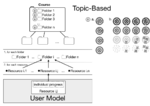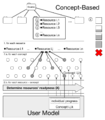PERSEUS
Overview
PERSEUS is a Personalization Service Engine. It provides adaptive support for non-personalized (educational) hypermedia systems by abstracting content presentation/aggregation from user modeling. PERSEUS protocols are based on RDF and RSS 1.0. Although, PERSEUS was initially developed for ADAPT2 framework, its data model permits seamless support of any other hypermedia application. Currently PERSEUS provides social navigation support, topic-based navigation support, concept-based navigation support, and adaptive recommendation.
Architecture
PERSEUS resides between the user interface (e.g. portal) and the user modeling server. The major sources of information for it are the content model (structure of the adapted hyperspace) and the user model (information about users). PERSEUS is comprised of three major components: adaptation strategies, visualization model, and data model.
Data model plays a central role in structuring the process of acquiring data from the environment. Items of data model – called data contexts – contain several types of information. These include addresses of the user modeling servers for acquiring the user data, access points to data stores (relational and/or semantic), URIs and URLs marking entry points to data stores, URI/URL patterns to filter/select resources of interest in the content model, etc.
Adaptation strategies (or [personalization] services ) are the scenarios used to produce the adaptation. They prescribe what kind of data should be obtained from the available sources and how it should be processed. The sources are specified in data contexts or could be the results of other adaptation strategy (chained adaptations). Relative independence of adaptation strategies allows them to be (re-)used with multiple data contexts.
Visualization model is comprised of special entities called visualizers. Visualizers contain rules prescribing how the continuous data produced by adaptation strategies (for example various measures of interest, importance, knowledge, etc.) can be presented to the user. Often these rules control how ranges of continuous values are mapped to discrete visual annotations. Visualizers, just like the data contexts are relatively independent from adaptation strategies. Different visualizers can be selectively used with one adaptation strategy and also the same visualizer to be used with different adaptation strategies.
Adaptation Strategies
Below are the schematic representations of the three major adaptation techniques implemented in PERSEUS: social-based, topic-based, and concept-based navigation.
Schema of social-based navigation in PERSEUS
Schema of topic-based navigation in PERSEUS
Schema of concept-based navigation in PERSEUS
Publications
- Yudelson, M. (2010) Providing Service-based Personalization in an Adaptive Hypermedia System. Doctoral Dissertation, University of Pittsburgh. ETD
- Yudelson, M. and Brusilovsky, P.. (2008). Adaptive Link Annotation in Distributed Hypermedia Systems: The Evaluation of a Service-Based Approach. In W. Nejdl, J. Kay, P. Pu, and E. Herder (Eds.), 5th International Conference on Adaptive Hypermedia and Adaptive Web-Based Systems (AH 2008), (pp. 245-254). DOI
- Zadorozhny, V., Yudelson, M., and Brusilovsky, P. (2008) A Framework for Performance Evaluation of User Modeling Servers for Web Applications. Web Intelligence and Agent Systems 6(2), 175-191. DOI
- Yudelson, M., Brusilovsky, P., and Zadorozhny, V. (2007) A user modeling server for contemporary adaptive hypermedia: An evaluation of the push approach to evidence propagation. In Conati, C., McCoy, K. F., and Paliouras, G. Eds., User Modeling, volume 4511 of Lecture Notes in Computer Science, pp 27-36. Springer, 2007. PDF DOI
See also
- ADAPT2 - Advanced Distributed Architecture for Personalized Teaching and Training
- Knowledge Tree
- Standardization: PERSEUS RDF Binding
- PERSEUS adaptation for Ensemble project





